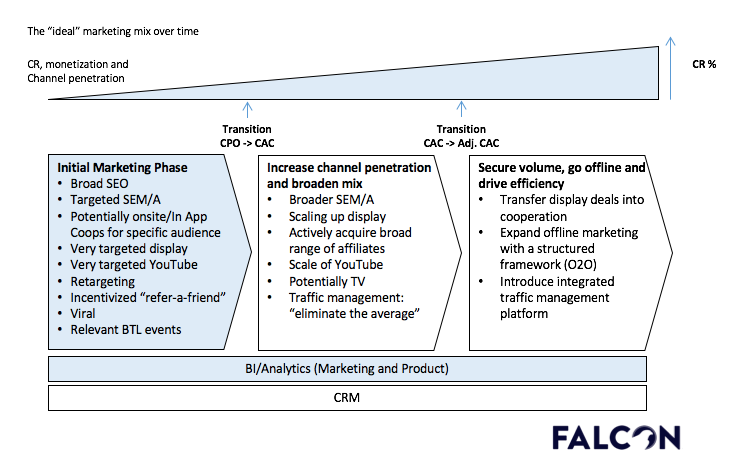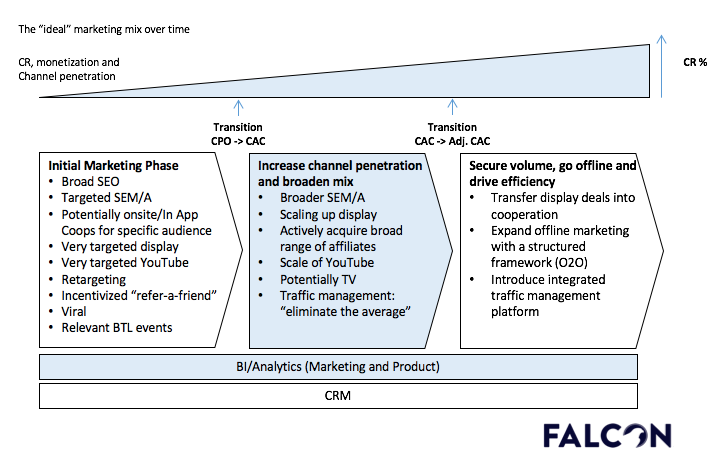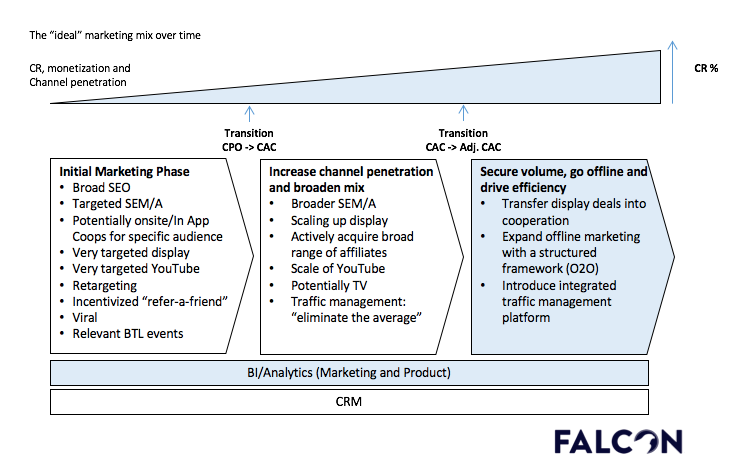We put the “perfect marketing mix” into 3 phases

This Monday morning I received an email from a friend of mine who is running a PR agency. He asked me something that I got asked several times over the last decade:
From: Eric
To: MaxSubject: Starting our eCommerce company
Hi Max,
I am starting a new eCommerce company. Which activities & channels should I launch first?Best,
Eric
My short answer: “Let me write an article and share it with you.”
My long answer is below:
I have worked with 20+ successful (and not so successful) e-commerce companies over the last decade. Over time, I wanted to put a methodology to the thinking, so that it is not just a small number of people who can do the job.
This is my response to Eric and all entrepreneurs on initial stages. I have to admit that this is not invented by myself. I have first learned about it from Dr. Florian Heinemann during one of his infamous presentations. I did, however, adapt it for the APAC market.

The “ideal” marketing mix over time
In general, when we think about the “ideal” marketing mix we are thinking about conversion rate (CR), monetisation and channel penetration. There is no right or wrong but more of a time when you realise that you have “milked the cow” and have to move on (aka be more sophisticated). This transition is usually marked by moving from a CPO (=Cost Per Order) to a CAC (=Customer Acquisition Cost) and eventually to an adjusted CAC (truly understand monetisation strength of each channel/activity and maximising the profit potential) model.
Also read: 5 ways AI can optimise e-commerce logistics, planning, and engagement
In case you have not done it yet, you should read about the FALCON Conversion Framework as this current article is focusing on marketing effectiveness (as part of the FALCON Conversion Framework). The basis is a BI/Analytics and CRM framework that is set up from the beginning. Yes, from the beginning. Don’t start to think about your CRM solution in Year 3, 5 or even 10. I mean, you can but it will be very, very painful.
We put the “perfect marketing mix” into 3 phases: Initial marketing phase, Increase channel penetration and broaden mix and lastly, secure volume, go offline and drive efficiency. Let’s slice & dice it.
Initial marketing phase
This is usually a phase when you spend less than U$10k per month on media and have (or you are going to) launch your e-commerce site. In this phase, we recommend to be very specific with your paid channels (targeted SEM/A, Display and FB targeting). This will help you to capture your ‘right’ audience. You don’t want to spend all your marketing $$ to test what sticks. Unless you are Rocket Internet and willing to literally burn money on media. As you are a SMART marketer you set up your re-targeting pixel for all paid channels. That’s where you can get relevant users back to your site.
Your master exercise will be SEO: Create significant amount of content and optimise your content in a broad manner. Why? This will be your best on-site research tool. I will get to this topic in a separate article.
Something to implement from day-1 is a ‘refer-a-friend’ mechanism. Not only is it proven that recommendations show some of the highest conversion rates (see Referral Marketing: average order value uplift) but it also helps you to improve your growth multiplier. This kind of growth loop will compound over time and this compounded growth rate will significantly improve your conversion rate.
Lastly, try some of the (good value for money) industry events. We have seen that it can be a very good (aka targeted) way to acquire a lot of leads. A lot of relevant leads. Just to highlight again that you should have set up your CRM from day zero.
Now you are starting to understand dependencies (and consequences) of your activities and you are transitioning from a simple CPO- to CAC-model. Welcome to your next phase:

Phase 2 : Increase channel penetration and broaden mix
Channel penetration and broadening the mix
This phase is characterised by two things that go hand in hand: You scale (what works) and you eliminate (what doesn’t work). Sounds simple but trust me, this can be very intellectually challenging (and in a case of Deliveroo willl take up to testing 120,000 keyword combinations before you hit the ‘perfect’ set of keywords).
First, you start to get broader with your paid channels: You will generate more volume with your prospecting campaigns on facebook and at the same time, you are broadening your SEM keywords. By broadening I mean you increase the number of campaigns by a minimum of 10x!
Display goes hand-in-hand with your increase in marketing spend in Facebook (though we prefer Facebook over display for a variety of reasons). At this stage, you will also start to actively acquire a broad range of affiliates. It takes time to (really) make affiliate work. But the good thing is that affiliate is usually based on a performance-based remuneration fee. And as long as you don’t work with a spammy affiliate partner (ehmm … Uber … ehmmm) then it can play out very well for you.
But expect 3 to 6 months for your affiliate to work. Meaning that you understand which partner is generating quality user/conversions and which not. At the end of this phase, cut down the partners who delivered cheap/not-converting traffic and double-down on your ‘good’ partner. By doubling-down, I mean to offer them a very attractive performance remuneration. Technically they are doing your job as marketer.
Also read: 3 lessons I learned balancing a successful e-commerce business with a full-time day job
On purpose, I have put ‘potentially TV’. Why? You really have to know what you are doing there. I gave a good example on how it can work together with your SEM here but in APAC mostly it doesn’t work well, as TV stations haven’t realised the reach-partnership model with e-commerce companies (at least not to my knowledge). If not you will spend A LOT of money on literally nothing but your ego (“Hey, have you seen our TV spot? No? Strange.”) then put it in the category ‘potentially TV’.
One of the most important parts in this phase is the “eliminate the average” activity. This is part analytical, part creative (too look at the right elements of targeting, message, placement and creative) and part executional. We tried to put a clear daily, weekly, bi-weekly and monthly optimisation checklist on certain parameters. But this is only the guideline to follow — the performance marketer will have to know the brand and its audiences before making a judgment call.

Phase 3 : Secure volume, go offline and drive efficiency
Now, after spending hundreds of thousands of dollar (and secured your Series B+) you start to literally secure volume, go offline and drive efficiency. Note that we see it, unfortunately, too often that companies close their Series A and put the majority of money into ineffective ‘reach’ channels. Why? Because you have got money. But in 99% of the cases, you will regret the choice that you did the billboard marketing all over Singapore too early. Emphasis is on ‘too early”. I think it can be a great and effective channel (as long as it is structurally thought through with all your paid & unpaid marketing activities).
In this phase, you pretty much know your audience incredibly well, your reach partner even better and you have got a senior marketing team or agency partner on board who will manage your integrated traffic management platform.
So next time, I will receive an email from Eric (or you) I will refer to this article.
—-
How to scale your e-commerce company was first published in THE STARTUP – Medium‘s largest entrepreneurship publication.
e27 publishes relevant guest contributions from the community. Share your honest opinions and expert knowledge by submitting your content here.
The post How to scale your e-commerce company from zero to $100M appeared first on e27.
Source: E27

